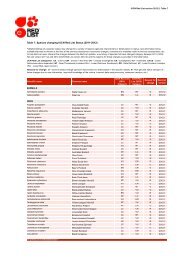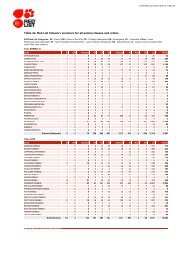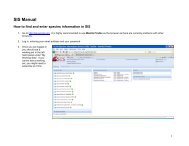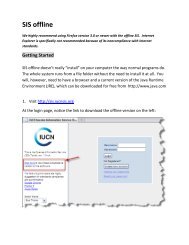IUCN Red List Guidelines - The IUCN Red List of Threatened Species
IUCN Red List Guidelines - The IUCN Red List of Threatened Species
IUCN Red List Guidelines - The IUCN Red List of Threatened Species
Create successful ePaper yourself
Turn your PDF publications into a flip-book with our unique Google optimized e-Paper software.
<strong>Red</strong> <strong>List</strong> <strong>Guidelines</strong> 8<br />
assigned to taxa on the basis <strong>of</strong> quantitative criteria that are designed to reflect varying<br />
degrees <strong>of</strong> threat <strong>of</strong> extinction. <strong>The</strong>se criteria will be discussed further in the next section.<br />
<strong>The</strong> category Near <strong>Threatened</strong> is applied to taxa that do not qualify as threatened now, but<br />
may be close to qualifying as threatened. <strong>The</strong> category Least Concern is applied to taxa that<br />
do not qualify (and are not close to qualifying) as threatened or near threatened.<br />
<strong>The</strong> remaining two categories do not reflect the threat status <strong>of</strong> taxa. <strong>The</strong> category Data<br />
Deficient highlights taxa for which sufficient information is lacking to make a sound status<br />
assessment. <strong>The</strong> inclination to assess taxa as Data Deficient may be very strong; it should be<br />
emphasized that assessors must use all data available in full when making a <strong>Red</strong> <strong>List</strong><br />
assessment. Precise information on scarce taxa is usually lacking, and although the criteria<br />
are highly quantitative and defined, one can use projections, assumptions and inferences in<br />
order to place a taxon in the appropriate category. Since Data Deficient is not a category <strong>of</strong><br />
threat, taxa placed in this category are not so obviously targets for conservation action,<br />
although their needs might be very great. Assessors should use whatever information is<br />
available and relevant to make assessments and place taxa into the Data Deficient category<br />
only when there is really no alternative. Guidance on handling uncertainty is especially<br />
relevant in the case <strong>of</strong> poorly known taxa (see section 3.2). <strong>The</strong> category Not Evaluated<br />
applies to taxa that have not yet been evaluated against the <strong>Red</strong> <strong>List</strong> Criteria.<br />
Taxa in all <strong>of</strong> the <strong>IUCN</strong> <strong>Red</strong> <strong>List</strong> Categories, except LC and NE, are normally presented in<br />
the <strong>Red</strong> <strong>List</strong> and, consequently, are referred to as "red-listed". <strong>The</strong> 2003 update <strong>of</strong> the <strong>IUCN</strong><br />
<strong>Red</strong> <strong>List</strong> <strong>of</strong> <strong>Threatened</strong> <strong>Species</strong> and all subsequent updates will include all taxa assessed as<br />
LC and information about them will be documented, although these taxa would not be<br />
referred to as "red-listed". This is especially important, for example, for taxa that were redlisted<br />
in an earlier edition, but have since been down-listed.<br />
(Evaluated)<br />
(Adequate data)<br />
Not Evaluated (NE)<br />
(<strong>Threatened</strong>)<br />
Data Deficient (DD)<br />
Figure 2.1. Structure <strong>of</strong> the <strong>IUCN</strong> <strong>Red</strong> <strong>List</strong> Categories<br />
Extinct (EX)<br />
Extinct in the Wild (EW)<br />
Critically Endangered (CR)<br />
Endangered (EN)<br />
Vulnerable (VU)<br />
Near <strong>Threatened</strong> (NT)<br />
Least Concern (LC)






